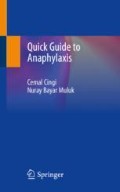Abstract
There are a number of frequently encountered conditions that can mimic anaphylaxis. They include acute generalised urticaria, severe angioedema, abrupt deterioration in asthma, fainting, and anxiety or panic attacks. In addition, anaphylaxis can present occasionally as sudden collapse and show no skin signs; hence, it may be mistaken for other conditions presenting as syncope or as threatening syncope. Other potential differential diagnoses include choking and pruritus from external causes, important to consider in the case of neonates and younger children [1–3].
Access this chapter
Tax calculation will be finalised at checkout
Purchases are for personal use only
References
Kelso JM. Differential diagnosis of anaphylaxis in children and adults. In: Bochner BS, Felsdweg AM, editors. UpToDate. http://www.uptodate.com/contents/differential-diagnosis-of-anaphylaxis-in-children-and-adults. Accessed 12 July 2016.
Simons FE, Ardusso LR, Bilò MB, et al. World allergy organization guidelines for the assessment and management of anaphylaxis. World Allergy Organ J. 2011;4:13.
Simons FE, Frew AJ, Ansotegui IJ, et al. Risk assessment in anaphylaxis: current and future approaches. J Allergy Clin Immunol. 2007;120:S2.
Simons FE, Frew AJ, Ansotegui IJ, et al. Practical allergy (PRACTALL) report: risk assessment in anaphylaxis. Allergy. 2008;63:35–7.
Martelli A, Ghiglioni D, Sarratud T, Calcinai E, Veehof S, Terracciano L, Fiocchi A. Anaphylaxis in the emergency department: a paediatric perspective: differential diagnosis. Medscape. http://www.medscape.org/viewarticle/583328_4. Accessed 12 July 2016.
Zuraw BL. Clinical practice. Hereditary angioedema. N Engl J Med. 2008;359:1027.
Levy JH, Freiberger DJ, Roback J. Hereditary angioedema: current and emerging treatment options. Anesth Analg. 2010;110:1271.
Bork K, Hardt J, Witzke G. Fatal laryngeal attacks and mortality in hereditary angioedema due to C1-INH deficiency. J Allergy Clin Immunol. 2012;130:692.
Sampson HA, Muñoz-Furlong A, Campbell RL, et al. Second symposium on the definition and management of anaphylaxis: summary report—Second National Institute of Allergy and Infectious Disease/Food Allergy and Anaphylaxis Network symposium. J Allergy Clin Immunol. 2006;117:391.
Lieberman PL. Anaphylaxis. In: Adkinson Jr NF, Bochner BS, Busse WW, et al., editors. Middleton’s allergy: principles and practice. 7th ed. St. Louis: Mosby; 2009. p. 1027.
Worm M, Edenharter G, Ruëff F, et al. Symptom profile and risk factors of anaphylaxis in Central Europe. Allergy. 2012;67:691.
Palmiere C, Comment L, Vilarino R, et al. Measurement of β-tryptase in postmortem serum in cardiac deaths. J Forensic Legal Med. 2014;23:12.
Triggiani M, Patella V, Staiano RI, et al. Allergy and the cardiovascular system. Clin Exp Immunol. 2008;153(Suppl 1):7.
Triggiani M, Montagni M, Parente R, Ridolo E. Anaphylaxis and cardiovascular diseases: a dangerous liaison. Curr Opin Allergy Clin Immunol. 2014;14:309.
Campbell RL, Hagan JB, Li JT, et al. Anaphylaxis in emergency department patients 50 or 65 years or older. Ann Allergy Asthma Immunol. 2011;106:401.
Noyes BE, Kemp JS. Vocal cord dysfunction in children. Paediatr Respir Rev. 2007;8:155.
Bahrainwala AH, Simon MR. Wheezing and vocal cord dysfunction mimicking asthma. Curr Opin Pulm Med. 2001;7:8.
Aldrich LB, Moattari R, Vinik AL. Distinguishing features of idiopathic flushing and carcinoid syndromes. Arch Intern Med. 1988;148:2614–8.
Izikson L, English JC 3rd, Zirwas MJ. The flushing patient: differential diagnosis, workup, and treatment. J Am Acad Dermatol. 2006;55:193.
Kulke MH, Mayer RJ. Carcinoid tumors. N Engl J Med. 1999;340:858.
Lieberman P. Anaphylaxis. Med Clin N Am. 2006;90:77–95.
Settipane GA. The restaurant syndromes. Arch Intern Med. 1986;146:2614–8.
Becker K, Southwick K, Reardon J, et al. Histamine poisoning associated with eating tuna burgers. JAMA. 2001;285:1327.
Ricci G, Zannoni M, Cigolini D, et al. Tryptase serum level as a possible indicator of scombroid syndrome. Clin Toxicol (Phila). 2010;48:203.
AAITO-IFIACI Anisakis Consortium. Anisakis hypersensitivity in Italy: prevalence and clinical features: a multicenter study. Allergy. 2011;66:1563.
Rodríguez E, Anadón AM, García-Bodas E, et al. Novel sequences and epitopes of diagnostic value derived from the Anisakis simplex Ani s 7 major allergen. Allergy. 2008;63:219.
Webber CM, England RW. Oral allergy syndrome: a clinical, diagnostic, and therapeutic challenge. Ann Allergy Asthma Immunol. 2010;104:101.
Pascal M, Muñoz-Cano R, Reina Z, et al. Lipid transfer protein syndrome: clinical pattern, cofactor effect and profile of molecular sensitization to plant-foods and pollens. Clin Exp Allergy. 2012;42:1529.
Sherenian MG, Clee M, Schondelmeyer AC, et al. Caustic ingestions mimicking anaphylaxis: case studies and literature review. Pediatrics. 2015;135:e547.
Lieberman P. Anaphylaxis and anaphylactoid reactions. In: Middleton Jr E, editor. Allergy: principles and practice. 5th ed. St. Louis: Mosby; 1998. p. 1079–92.
Koike T, Tatewaki W, Aoki A. Brief report: severe symptoms of hyperhistaminemia after the treatment of acute promyelocytic leukemia with tretinoin. N Engl J Med. 1992;327:385–7.
Wellhoener P, Weitz G, Bechstein W, et al. Severe anaphylactic shock in a patient with a cystic liver lesion. Intensive Care Med. 2000;26:1578.
Sivagnanam S, Deleu D. Red man syndrome. Crit Care. 2003;7:119–20.
Patterson R, Schatz M. Factitious allergic emergencies: anaphylaxis and laryngeal edema. J Allergy Clin Immunol. 1975;56:152–9.
Goodman DL, O’Connel MA, Sklarew PR. Vocal cord dysfunction presenting as anaphylaxis. J Allergy Clin Immunol. 1991;87:278.
Greenberger PA, Lieberman P. Idiopathic anaphylaxis. J Allergy Clin Immunol Pract. 2014;2:243.
Bahna SL, Oldham JL. Munchausen stridor-a strong false alarm of anaphylaxis. Allergy Asthma Immunol Res. 2014;6:577.
Druey KM, Greipp PR. Narrative review: the systemic capillary leak syndrome. Ann Intern Med. 2010;153:90.
Dowden AM, Rullo OJ, Aziz N, et al. Idiopathic systemic capillary leak syndrome: novel therapy for acute attacks. J Allergy Clin Immunol. 2009;124:1111.
Gompels MM, Lock RJ, Abinun M, et al. C1 inhibitor deficiency: consensus document. Clin Exp Immunol. 2005;139:379–94.
Sahnoun I, Harmouche H, Aouni M, et al. Systemic Capillary Leak Syndrome: two case reports. Rev Int Med. 2005;26:409–14.
Gleich GJ. Episodic angioedema associated with eosinophilia. N Engl J Med. 1984;310:1621–6.
Author information
Authors and Affiliations
Rights and permissions
Copyright information
© 2020 Springer Nature Switzerland AG
About this chapter
Cite this chapter
Cingi, C., Bayar Muluk, N. (2020). Differential Diagnosis for Anaphylaxis. In: Quick Guide to Anaphylaxis. Springer, Cham. https://doi.org/10.1007/978-3-030-33639-4_7
Download citation
DOI: https://doi.org/10.1007/978-3-030-33639-4_7
Published:
Publisher Name: Springer, Cham
Print ISBN: 978-3-030-33638-7
Online ISBN: 978-3-030-33639-4
eBook Packages: MedicineMedicine (R0)

